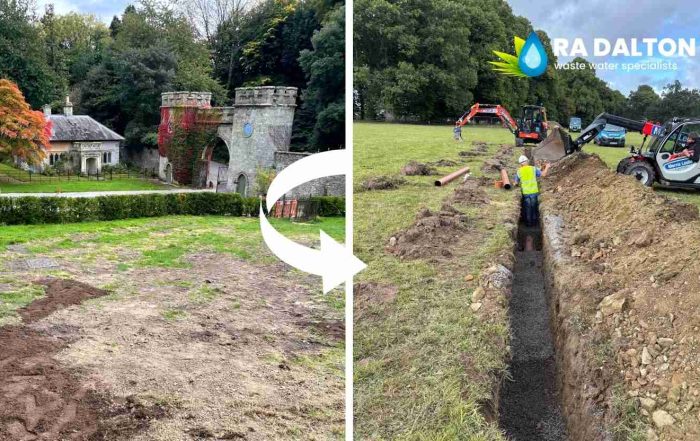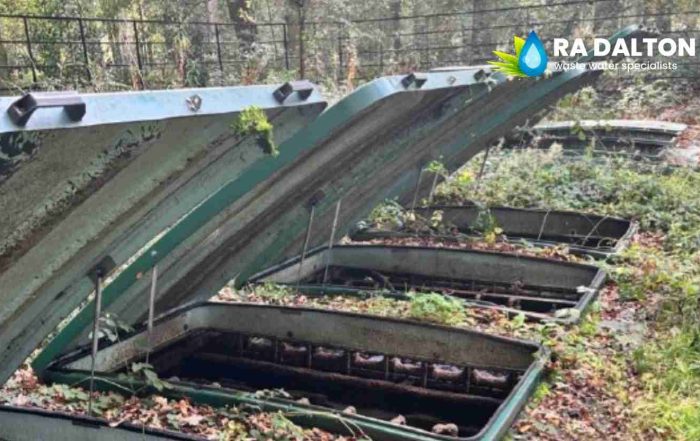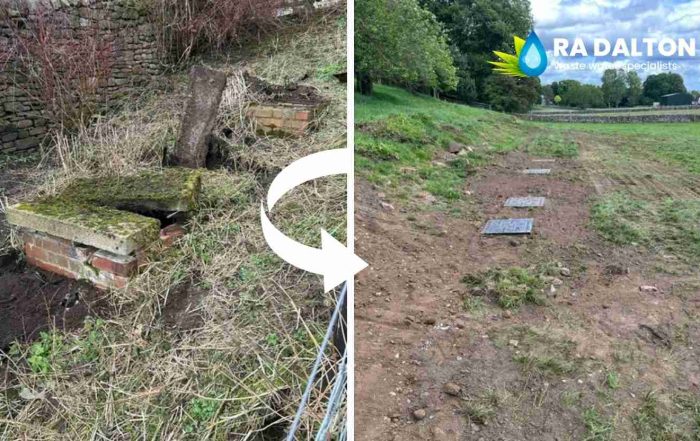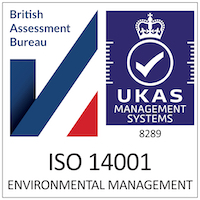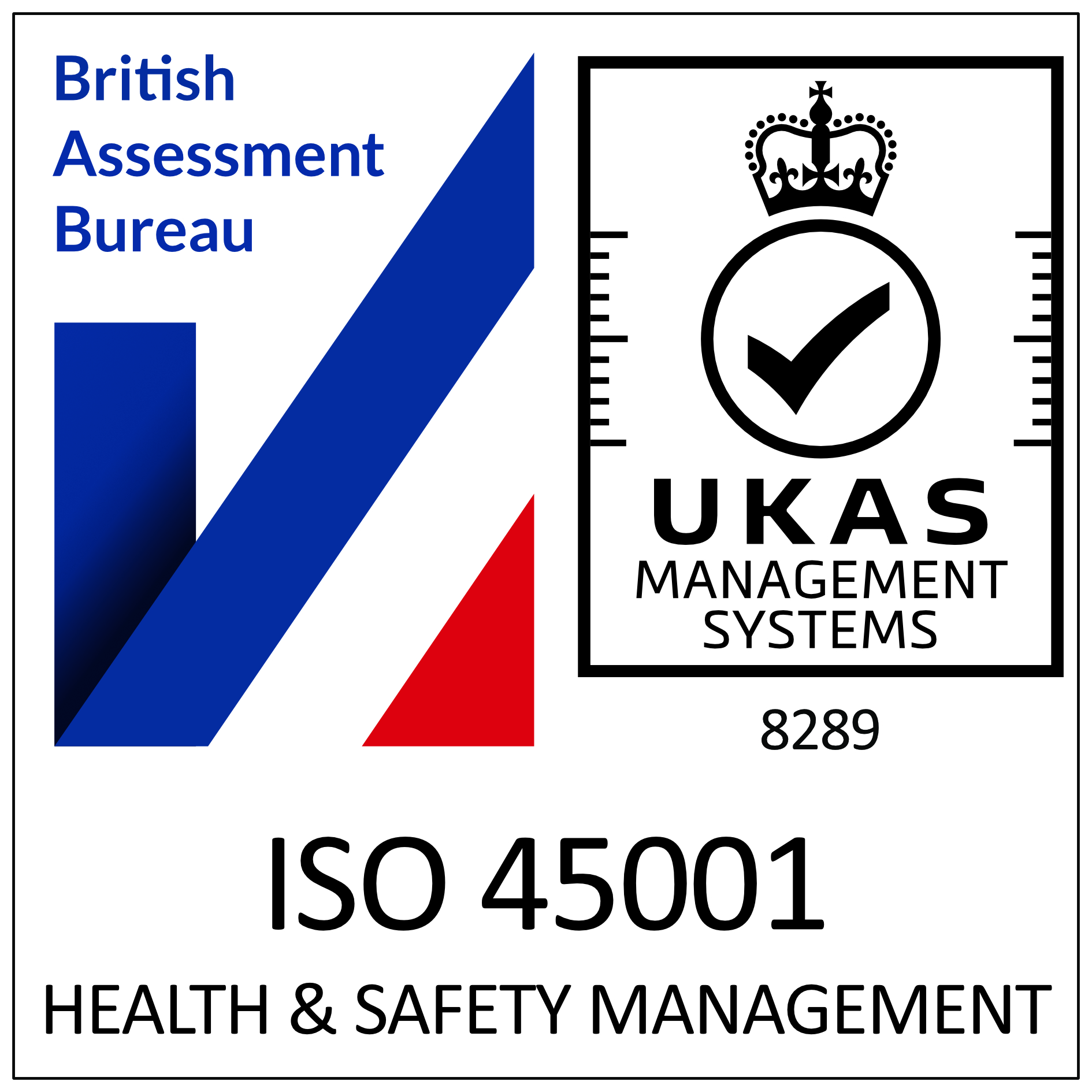RA Dalton Success Stories
RA Dalton Ltd are the Klargester number one accredited installer covering the whole of the UK.
Balancing Conservation and Innovation: Sustainable Drainage in a Historic Landscape
RA Dalton was appointed to deliver a sensitive and complex wastewater drainage upgrade at a prestigious National Trust heritage site, set within protected grazing meadows and gravel pathways. The project required careful planning, environmental compliance and collaboration with a wide team of professionals over a four-week programme.
Project Scope & Objectives
The primary goal was to eliminate the existing septic tanks and connect to the drainage network on site which ultimately discharges to the mains sewer system, ensuring long-term functionality while preserving the site’s historical and ecological integrity. As Europe’s largest conservation charity, the National Trust safeguards coastline, countryside and heritage buildings – making this a high-profile and sensitive undertaking.
RA Dalton submitted a successful competitive tender and maintained open communication throughout, issuing regular progress reports to ensure the Trust could continue its operations with minimal disruption.
Site Zones & Execution Strategy
The site was divided into three operational zones:
- Zone 1: Base camp and archway
- Zone 2: Stable yard
- Zone 3: Parkland
Works commenced in Zone 3, progressing methodically across the estate with precision and care. The team adhered to strict environmental compliance standards, preserving the natural landscape and archaeological features.
Environmental & Archaeological Considerations
Key measures included:
- Tree protection zone assessments
- Coordination with building control
- On-site meetings to confirm pipework routes
- Consultant oversight to safeguard archaeological findings
During excavation, underground discoveries required protocol adjustments to preserve historical artefacts. Pipework diameters were carefully calculated to ensure clearance over sensitive areas, including stone surfaces near iron railings.
Livestock Management & Site Safety
Unexpected livestock presence required swift coordination with local farmers. RA Dalton implemented secure fencing solutions to safely segregate work zones, protecting both employees and animals, maintaining site integrity.
Weather & Logistics Planning
Variable weather – from heavy rainfall to extreme dry spells – prompted dynamic planning to mitigate risks such as wildfires. A comprehensive risk assessment and updated RAMS report were completed.
To protect shared access roads, deliveries were strategically scheduled. Gravel materials were transported via single-trip vehicles, avoiding large articulated lorries. Machinery remained on-site to minimise changeovers and maintain efficiency.
Arboricultural Supervision
An Arboricultural Method Statement accompanied the planning submission. RA Dalton’s contracts manager met with a chartered arboriculturist to confirm tree protection fencing installations. Heras panels were securely joined and pinned to safeguard root protection areas, including a veteran sweet chestnut tree. Marker paint was used to designate trenching zones requiring additional protection.
Works Programme Overview
Week 1: Site Setup & Initial Investigations
- Delivery of welfare unit, machinery, and Heras fencing
- Installation of tree protection fencing and signage in Zone 3
- CAT scan to locate existing pipework and underground services
- Commencement of trial pits to assess ground conditions
Week 2: Zone 3 Completion & Zone 1 Commencement
- Construction of inspection chambers and completion of works in Zone 3
- Expansion of fencing and signage into Zones 1 and 2
- CAT scan and service identification in Zone 1
- Excavation and exposure of existing pipework connections
- Installation of backdrop chamber and pipe runs
Week 3: Pipe Lining & Courtyard Excavation
- Completion of pipe lining in Zone 1
- Start of works in Zone 2, progressing through the courtyard to the road crossing
Week 4: Final Works & Site Restoration
- Flow diversion, snagging works and full site tidy-up
Engineer’s Insight
“For me there were two highs during the project. The first was having a reasonably dry spell (apart from the odd thundershower)! to get through the main field, which ran along the frontage of the main house. If this had been wet, it would have been quite detrimental to the look of the site.
The second, was after spending a month setting everything up, I turned the flow in the first manhole to see everything flowing well to its termination point at the bottom of the hill.
I have worked on several National Trust projects now and have thoroughly enjoyed them as they are all quite special for different reasons. We had certain falls to work to in the main field so that we didn’t disturb the footings of a much older castle building.
Overall it was a very good experience. Everyone on site was pleasant and helpful, and we were trusted to carry out our works to the standards that we like to leave behind and I’m sure the National Trust expects.
The premise of these works was to eliminate the two septic tanks in the field and divert the drainage to treatment works which I’m sure will be an environmental benefit”.
— Jules, RA Dalton Installation Foreman
Client Updates & Final Progress
Regular updates were shared with the client, including:
- Installation of the inlet inspection chamber
- Completion of 80% of pipework through parkland
- Trench backfilling and turf reinstatement
- Coordination with building control and gradient adjustments
During a scheduled site closure, RA Dalton excavated a road crossing to 600mm depth, confirming no services were encountered. The trench was infilled with concrete, and the tarmac surface reinstated, allowing road access to resume by mid-morning.
We’re incredibly proud to have partnered with the National Trust on this meaningful project, where our commitment to environmental stewardship and technical excellence helped protect a treasured landscape for future generations.











